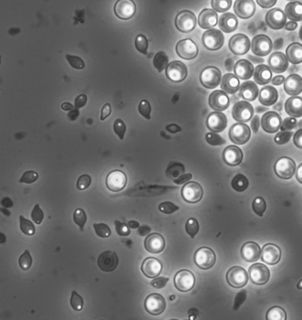Northern root-knot nematode is a species of vegetable pathogens which produces tiny galls on around 550 crop and weed species. They invade root tissue after birth. Females are able to lay up to 1,000 eggs at a time in a large egg mass. By surviving harsh winters, they can survive in cold climates.

Root-knot nematodes are plant-parasitic nematodes from the genus Meloidogyne. They exist in soil in areas with hot climates or short winters. About 2000 plants worldwide are susceptible to infection by root-knot nematodes and they cause approximately 5% of global crop loss. Root-knot nematode larvae infect plant roots, causing the development of root-knot galls that drain the plant's photosynthate and nutrients. Infection of young plants may be lethal, while infection of mature plants causes decreased yield.

Meloidogyne incognita, also known as the "southern root-nematode" or "cotton root-knot nematode" is a plant-parasitic roundworm in the family Heteroderidae. This nematode is one of the four most common species worldwide and has numerous hosts. It typically incites large, usually irregular galls on roots as a result of parasitism.
Arenaria, a Latin word meaning sand-loving, may refer to:

Meloidogyne arenaria is a species of plant pathogenic nematodes. This nematode is also known as the peanut root knot nematode. The word "Meloidogyne" is derived from two Greek words that mean "apple-shaped" and "female". The peanut root knot nematode, M. arenaria is one of the "major" Meloidogyne species because of its worldwide economic importance. M. arenaria is a predominant nematode species in the United States attacking peanut in Alabama, Florida, Georgia, and Texas. The most damaging nematode species for peanut in the USA is M. arenaria race 1 and losses can exceed 50% in severely infested fields. Among the several Meloidogyne species that have been characterized, M. arenaria is the most variable both morphologically and cytologically. In 1949, two races of this nematode had been identified, race 1 which reproduces on peanut and race 2 which cannot do so. However, in a recent study, three races were described. López-Pérez et al (2011) had also studied populations of M. arenaria race 2, which reproduces on tomato plants carrying the Mi gene and race 3, which reproduces on both resistant pepper and tomato.
Meloidogyne javanica is a species of plant-pathogenic nematodes. It is one of the tropical root-knot nematodes and a major agricultural pest in many countries. It has many hosts. Meloidogyne javanica reproduces by obligatory mitotic parthenogenesis (apomixis).
Meloidogyne chitwoodi is a plant pathogenic root-knot nematode that is a crop pest of potatoes, carrots, and black salsify. Root-knot nematodes such as M. chitwoodi cause the production of root-knot galls when their larvae infect the plant's roots and capture nutrients stored in the roots.
Meloidogyne acronea, the African cotton root-knot nematode or African cotton root nematode, is a plant pathogenic nematode affecting pigeonpeas. It is also an invasive species.
Meloidogyne artiellia, the British root-knot nematode, is a plant pathogenic nematode, infecting barley and chickpea. It is also an invasive species.
Meloidogyne brevicauda is a plant-parasitic nematode. It is also called tea root-knot nematode, mature tea nematode or Indian root-knot nematode. It is a member of the root-knot nematodes, which was identified by C. A. Loos in 1953 in Sri Lanka.
Meloidogyne gajuscus is a plant pathogenic nematode infecting African daisies.
Meloidogyne naasi, the barley root-knot nematode or cereal root-knot nematode, is a plant pathogenic nematode, and also an invasive species. The nematode occurs as the primary root-knot pathogen on golf courses and turf in the Northeast United States, although it is unclear as to whether the pathogen is native or introduced. In 2019 it was reported damaging cereal and grass crops in Northern Ireland.
Meloidogyne partityla is a plant pathogenic nematode infecting pecan. One of the first described cases of this nematode where noted in pecan trees in South Africa by Brito et al. (2013). It is thought to have been introduced into South Africa by pecan seedlings that came from the United States. Today, this nematode is seen infecting pecan trees in Arizona, Arkansas, Florida, Georgia, New Mexico, Oklahoma, and Texas. They not only infect pecans, but they also infect the California black walnut, English walnut, shagbark hickory, and laurel oak. The first report in the US, was reported in South Carolina in which it infected laurel oaks but later started infecting neighboring pecan trees in the shared orchards. The health of infested trees continue to decline every year.
Citrus root-knot nematode may refer to:
There are many plant-parasitic species in the root-knot nematode genus (Meloidogyne) that attack coffee such as M. incognita, M. arenaria, M. exigua, M. javanica and M. coffeicola. Study has already shown interspecific variability coffee, in which show how this species can be adapting to new hosts and environments.
Meloidogyne enterolobii was originally described from a population collected from the pacara earpod tree in China in 1983. In 2001 it was reported for the first time in the continental USA in Florida. M. enterolobii is now considered as one of the most important root-knot nematode species because of its ability of reproducing on root-knot nematode-resistant bell pepper and other economically important crops.

The Pasteuriaceae are a family of nonmotile Gram-positive bacteria. They are moderately to strongly resistant to heat. Species in this family produce a septate mycelium with one refractile endospore. The mycelium grows bigger on one end to form sporangia and sometimes endospores. The size of the endospores is different for each species of the genus Pasteuria. Species of the family of Pastueriaceae are endoparasitic in plant, soil, and freshwater invertebrates.
Pasteuria is a genus of mycelial and endospore-forming, nonmotile gram-positive bacteria that are obligate parasites of some nematodes and crustaceans. The genus of Pasteuria was previously classified within the family Alicyclobacillaceae, but has since been moved to the family Pasteuriaceae.


